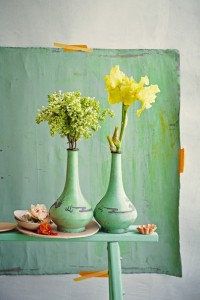Spring is here! Everywhere around me, I see crocuses and daffodils and tulips.  Green shoots are coming up on every available patch of soil. After this winter, flowers are a welcomed sight.
Green shoots are coming up on every available patch of soil. After this winter, flowers are a welcomed sight.
All the bright greens and blues and purples surrounding me remind me of all the interesting psychology behind them. So for our Part Two of the Psychology of Colors, let’s talk about the power behind some of my favorite spring shades.
Nothing says spring and new growth like the color green. As the most pervasive color in the natural world, and the easiest color for our eyes to see, it exists as a favorite color, second only to people’s love for blue. In fact, green was George Washington’s favorite color. Green relaxes you through and through, both mentally and physically with its soothing shades. It can help alleviate depression and anxiety while offering a sense of renewal. This color can be used for any room, as it carries a sense of balance and freshness.
Blue is the most universally favored color – and the most gender neutral too, as it is liked equally between men and women. Blue is a cool, spiritual color that promotes a sense of calm and peace. It also brings about a feeling of trust, and people are more productive in blue rooms. Fun fact: the most popular color for toothbrushes is blue. Just like green, blue is appropriate in every room, and can make a space feel very restful.
Purple
 Considered a royal color since the Caesars ruled, purple uplifts and inspires creativity. Purple has both the stimulation of red and blue’s calm in a perfect balance. It is often favored by very creative people for it’s mysterious whimsy. A lighter purple, such as a lavender or aubergine works well for a bedroom or powder room or even a living room to calm nerves. Kitchens benefit from brighter purples, which are reminiscent of fruit and make the room exciting.
Considered a royal color since the Caesars ruled, purple uplifts and inspires creativity. Purple has both the stimulation of red and blue’s calm in a perfect balance. It is often favored by very creative people for it’s mysterious whimsy. A lighter purple, such as a lavender or aubergine works well for a bedroom or powder room or even a living room to calm nerves. Kitchens benefit from brighter purples, which are reminiscent of fruit and make the room exciting.
It is so interesting to learn about the psychology behind each color. Have you ever noticed any of these colors affecting your mood? Which one is your favorite? Stay tuned for next week when we tackle the monochromatic shades of the color spectrum – white, grey, brown, and black!




Recent Comments